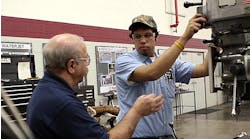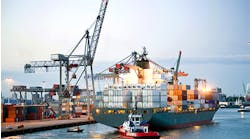Latest from Opinion
The U.S. Department of Defense defines “force multiplier” as a capability added or employed by a combat group that significantly improves its combat potential, enhancing mission success probability. A force multiplier might be anything from new weapons technology to fresh food in the mess hall… anything that perks up and improves the effectiveness of our world-class armed forces.
In the civilian world, in the manufacturing industry and among its managers and decision-makers, it’s not uncommon for problems to be addressed by throwing resources at them: devote more time to study it, spend more money to fix it, or demand more effort to resolve it. However, expending more resources is not always the wisest course of action, and much of that valuable time, money, or effort may end up wasted.
For anyone trained by the U.S. armed forces, a different approach will be recognizable. Due to their training and experiences, the ability to enhance the effectiveness of tools or assets (time, money, human resources) available now is really the critical factor behind the concept of working smarter not harder.
Sometimes adopting unknown or unfamiliar details of a new work process or strategy may be met with resistance by a team or an organization, because usually it requires people to embrace unfamiliar ideas or visions of the results. However, with force multipliers the foundational elements of the process (or strategy) usually are known already, and the change consists of an updated understanding of the process, or reconfiguring of other, correlated elements, that will improve its overall effectiveness and result.
Here are six force multipliers you can explore and implement to help you work smarter:
Technology — To be most effective in business and life it is necessary to react appropriately and effectively to changes. But being proactive — taking initiative — is where you will find that battles are won. Certainly, organizations like Apple or Facebook offer examples of a proactive stance on new technology that is leveraged into a significant force multiplying advantage. Technology might be the resource that defines force multiplier for our time.
However, as a resource, technology is moving into a plateau, a period during which everyone has access to the best available version, and this wide availability is balancing the competition. There will always be innovative products, game changers that propel organizations and individuals forward, but most of us aren’t engaged in enterprises that rely on innovation in that way.
Instead, the person who will be a force multiplier looks at technology and determines how its use extends effectiveness, for the multiplier or his organization. For example, a sales manager may implement an app that provides field sales reps with clients’ past order information more quickly. The reps use this information to respond proactively during calls. The smartphone has transformed the functional use of the once-innovative cell phone, and using the smartphone effectively advances the strategy of marketing and sales.
Data — The smartphone example underscores the importance of data. On the battlefield, it’s called intelligence, reconnaissance, or simply knowledge of one’s own personnel and hardware capabilities. Having complete and accurate information multiplies the chances of effective decision-making. Knowing where an enemy is, its numerical strength, and the weaponry it controls, permits an accurate and measured response rather than a blunt force reaction in the enemy’s general direction.
Consider the sales manager again. There’s no sense sending sales reps into a residential territory if he or she sells industrial supplies. Without knowledge of a territory, the rep’s effectiveness is diminished. Data is the factor that makes the rep’s selling effort more informed, and more effective
Collaboration — Delegation is one way to use human resources more effectively. In hierarchical organizations, top-down management is typical. It’s also quite inflexible. Information and innovation typically follow a hierarchical pattern, too.
The contemporary world is shifting to collaborative work groups because in a high-tech, information-driven age, new ideas spread laterally. Length of service with an organization is no longer a reliable measure of experience with information or technology. So, information is being shared laterally as well as hierarchically. Multi-pronged communication is becoming more natural, and more critical to success for anyone seeking to advance the awareness and responsiveness of an organization.
Psychology — In the military, but also in civilian organizations, positive morale is the most obvious psychological force multiplier. Positive morale motivates a fighting unit in precisely the same way it boosts the efforts of a workforce. Shared vision unifies effort and provides natural group cohesion.
Negative morale divides teams. In military terms, propaganda is a tool for negatively influencing opposing forces, and it can counteract a number of factors that might otherwise aid the enemy’s prospects for success.
Bringing down the competition may not be a practical goal in a business setting, but bolstering the positive and avoiding the negative in work groups is a critical function. Doing that well and consistently may be a force multiplier for the organization.
Strategy — A leader can fill the role of force multiplier by always thinking in terms of strategy and implementation. Effective leaders approach the knowledge of what resources can accomplish through tactical means. As the other aspects of force multiplication take effect, plans adapt to the increased capabilities. For instance, with the right tools and training, a sales team of three can increase sales comparable to the effect of six reps.
Leading by example — Becoming an effective force multiplier means maintaining constant attention to improving one’s own skills and knowledge. When you start asking more from others in your organization, they’ll rely more on you to lead them toward what you are requiring them to do. They know that you cannot and will not be working with them at all times, but they must know that you can do what you ask them to do, and that you are willing to work beside them. Demonstrating that readiness is a force multiplier technique.
As you become more aware of your force multiplier capabilities, you will realize that it’s an operating strategy, almost a lifestyle choice, with far-reaching implications. More than that, force multiplication inherently implies continual improvement of yourself, of your systems, and of your team. Rather than a slogan or an overlaid strategy, continuous improvement naturally emerges from the force multiplier process.
Elizabeth McCormick is a former U.S. Army Black Hawk pilot, and an authority on leadership. She is the author of “The P.I.L.O.T. Method: 5 Elemental Truths to Leading Yourself in Life.” Elizabeth teaches real-life, easy-to-apply strategies to boost employees’ confidence in organizational vision and their own leadership abilities. Learn more at www.YourInspirationalSpeaker.com.










